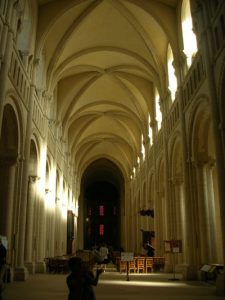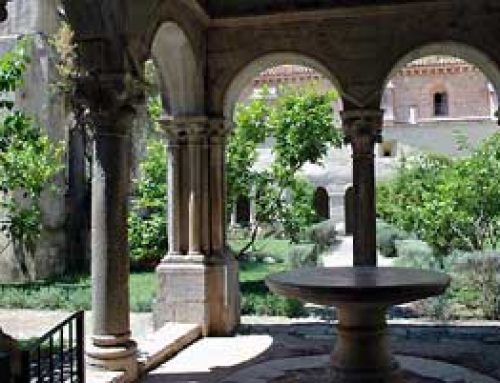
Six-part groin vault (Abbaye aux Dames, Caen, 1050 AD)
Stone roofs and fireproofing
In Romanesque churches, in the 1000s AD, architects or often just had a wood roof. But wood roofs were always catching on fire and burning down the whole church. A stone roof under the wooden roof served as fireproofing. So Romanesque churches sometimes had a stone roof with a barrel vault, under the wood roof.
Romanesque churches
Barrel vaults
Medieval architecture
All our medieval Europe articles
Disadvantage of barrel vaults
But a barrel vault was so heavy that the walls had to be very thick to hold it up, with only a few tiny windows. Then the church looked dark. That was okay when most of the churches were in southern France and Italy, where it’s sunny, but it was less good in northern France where it is often dark and rainy. As northern France conquered southern France and traded more, towns got richer and built bigger churches.
Medieval climate and weather
French kings conquer the south
How are groin vaults different?
Around 1050 AD, people began using a different kind of vault – the groin vault. It’s called a groin vault because the parts meet together in a V, like the V where your legs come together. You make a groin vault by building two barrel vaults that cross each other, so that they make an X. A groin vault can be rounded, as in Romanesque churches, or pointed, as in Gothic churches. Some have stone ribs that you can see, and some do not.
What’s Gothic architecture?
Where do pointed arches come from?
Groin vaults and buttresses
The main advantage of the groin vault is that it takes all the weight of the roof and concentrates it on just four points at the corners of each bay (each X). If you have a buttress at each corner, you don’t need to have a solid wall between those buttresses, because that wall isn’t holding much weight – it can be nearly all glass windows.
What is a buttress?
Stained glass windows

Four-part groin vault (Rouen, 1200s AD)
Six part groin vaults
Early medieval groin vaults, like those in the Abbaye aux Dames at Caen above, had six places where the weight came down – the corners of the X and the ends of another arch across the center. Laon cathedral, and Notre Dame in Paris, also used this six-part vault.
The Abbaye aux Dames
Laon cathedral
Notre Dame of Paris
Four part groin vaults
But by the 1200s most churches, like Chartres or Rouen, used a four-part vault, which needed fewer buttresses and allowed for more light to enter the cathedral through bigger windows.
Chartres Cathedral
Rouen Cathedral
Amiens Cathedral
Learn by doing: see if there is a church with a groin vault in your area
More about barrel vaults
A groin vault at Chartres Cathedral
Bibliography and further reading about groin vaults:
Arches to Zigzags: An Architecture ABC, by Michael J. Crosbie (2000). Shows what an arch is, or a gable, or an eave. For younger kids.
Eyewitness: Building, by Philip Wilkinson, Dave King, and Geoff Dann (2000). Lavishly illustrated, like other Eyewitness books for kids, and with good explanations of most architectural terms.
Cathedral: The Story of Its Construction, by David Macaulay (1981). Beautiful drawings and clear text explain exactly how medieval craftsmen built a groined vault. Easy reading.




